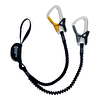Crag certification and classification, bolter responsibilities and training: the French example and Philipp Brass interview

 1 / 5
1 / 5 Philippe Brass
Philippe Brass
With his experience he actively took part in bolting crags in the Grenoble area, at Oisans and, of course, in rebolting Presles. This was an important step in the Department's program, at a cliff that is famous both nationally and internationally. In 1989, together with Grenoble friends and Patrick Cordier, at the time VTNO president, he designed the project to rebolt those routes at Presles that had unreliable bolts dating back to the '80's. This project was approved and received important funding from the Department's General Council. While the Rochers de Presles is still looked after by VTNO, for personal reasons Brass is no longer a member of the association. Nowadays he is interested in preserving alpine routes and the co-existence of the different styles at France's crags and in its mountains.
Philippe, first of all can you tell us if bolting is regulated in France?
There are no laws on this subject. But there are unwritten rules according to an area's location, its character and tradition. In certain cases the FFME (the French Federation of Mountaineering and Climbing, translator's note) can impose a certain course of action. The Sports Code (all laws affecting sport) states: "The delegated sports federations or, failing that, the recognized sports federations can define, each for their own discipline, technical standards, norms concerning safety and fixed gear located in the spaces, sites and routes related to the individual outdoor sports."
This means that the federation in charge (the FFME) has the power to define rules for the areas it manages. In practice, at those areas defined as being sport terrain (see question 3), FFME rules are applied. Elsewhere they are not.
The following example illustrates the point: no one prohibits you from establishing a new route at Presles or Tête d'Aval, but if you want to add a new route to Cimaï you have to respect the rules of the local FFME that looks after the crag.
Conversely, some laws of our Civil Code are applied more or less anywhere, depending on whether the area is located in private property or not, i.e. if the land owner consents to or prohibits rock climbing. Initially, bolting a cliff or crag was subject to French law more for access reasons than for how it is actually equipped.
So, as another example, if a foreigner comes to France, can he or she freely establish a new route or is there a precise procedure that must be followed?
It makes no difference whether someone French, Chinese, Italian or Swiss ... anyone can come and establish new routes in France. The only thing we ask those who want to bolt something new is, before they do so, to check with the local new routers and clubs, if these exist. It's clear, and basic common sense, that for crags that for crags such as Buoux that have already been extensively developed and have a rich climbing history, a new route will have to adhere to certain rules, even if these are not written on paper in a law. Having said that, everyone is free to add new routes in areas where no one has ever climbed before, as long as these are not subject to access or climbing restrictions such as the Massif des Ecrins, or within the Ailefroide area, as these are subject to the Écrins National Park access regulations.
We know that in France there is a distinction between sports crags and adventure terrain. Is there an exact definition for these two types?
This is an old theme but it's worth analysing to understand how things work here.
In 1962 several French clubs such as the CAF and the FFM united to create COSIROC (the committee that defends the interests of rock climbing areas). Its president Daniel Taupin did a terrific job of reviewing all climbing areas in France and publishing them all in a red book: the guide to all of France's natural climbing areas. In his book he made a distinction between the different areas, depending on whether they had been bolted according to the standards, of if they were more or less orientated to sport climbing. In 1985 the FFM transformed into the FFME, an organisation that is more centralized and one which focuses more on climbing.
The creation of a national climbing instructor license was decisive at this stage and it was precisely then that a distinction was officially made between sport climbing and "land of adventure" based on Taupin's work and that of COSIROC (for the French, Terrain d'Aventure, of adventure terrain, is more or less what most understand as alpine routes). The distinction doesn't only take into account the in-situ gear, but also the nature of the terrain. Rochers du Presles, for example, remains Terrain d'Aventure even if most routes are equipped with bolts. Equally, certain areas such as the multi-pitch climbs in the Calanques are classified as Terrain d'Aventure for liability reasons (we will ll examine this later). At Presles there are also some sport climbing areas, such as the crags Pierrot Beach and Balme Etrange. Now though there is a norm that classifies all natural climbing areas, published by the FFME. The definitive 2012 text distinguishes three different area types: bouldering, sports climbing, Terrain d'Aventure. The FFME text can be downloaded here.
How are the classic climbs respected in the Vercors area? Can they be re-equipped (or bolted even)? Is there an open debate, or who takes the decisions?
First there were debates within the FFME's departmental committees. In the past some climbers didn't agree on re-equipping certain routes, but nowadays there's an agreement thanks to this consultation between the climbers. This isn't law, merely an agreement, a sort of "charter" that climbers are asked to observe. Take Drôme for example, with its crags Archiane and Pelle. This is an interesting case in point. The charter states that climbing at these crags is a sort of alpinism, and that the routes conserve these characteristics: original gear, possibly some additional gear at the belays. Those bolts placed for personal reasons were removed. This is a fairly recent trend and it seems to work, contrary to what was done during the '90's at Presles.
By stating that these crags include "alpinism", the FFME climbing norms are completely bypassed meaning that the classic climbs aren't obliged to be bolted for security reasons.
Is there such a thing as a program about crag bolting and maintenance? If so, who is in charge?
Most sites have a program regarding the maintenance of sport climbs (obviously routes that were bolted sport climbs right from the start). These programs are essentially initiatives related to FFME climbers. In regions that have plenty of crags, such as the PACA, there are very serious, periodical maintenance programs that receive public funding. It is this public funding that has slightly changed climbing. Public spending has been used to fund the gear and replacement of old gear at cliffs such as Verdon, les Calanques, Saint-Victoire and, at a later stage, Presles. Each departmental committee appoints a commission comprised of climbers, sometimes mountain guides or instructors, whose job is to monitor the cliffs.
Is it true that the FFME finances the bolting, or is this still largely done on a voluntary basis?
Except for very rare examples, the FFME does not not finance bolting directly. Each departmental committee gathers the funds needed to acquire the gear and in some cases to pay the bolters. Often most climbers are generous resulting in the gear being funded by them. When there is an important project the departments or regions step in an pay the bolters. Some town councils have invested in a cliff, in much the same way as they invest in a new football field or swimming pool. Funding often comes from the sales of the local climbing guidebooks, published by the federation or clubs. Nowadays very few guidebooks are "private", at least those that deal with sports crags.
Is there a reference text that lists the materials and the right techniques that need to be applied when equip a crag? And is there such a thing as a professional, certified "bolter"?
Yes, there are documents published by FFME or ENSA (National School of Skiing and Mountaineering). These documents specify the materials that should be used on the basis of where the cliffs are, and indicate how they should be used. The FFME was appointed to compile federal norms of classification and bolting. There norms apply primarily to areas that are deemed suitable for sport climbing or for teaching beginners how to climb. The document is available on the internet. Furthermore, the departmental committees organise training sessions for bolters.
It has often been said that in France there are crags that are certified. But if an accident happens, not due to the inexperience of the climber, but due to a new route's negligence, whose responsibility is it? That of the Federation?
It's what we call the convention of use of affiliated crags. The convention is stipulated first of all between the land owner and the FFME departmental committee, sometimes with the town council on whose land the crag is located. From a legal point of view, responsibility shifts from the land owners to the FFME. In some cases the convention passed via the FFCAM (the Federation of Alpine Clubs – that does not have a ministerial mandate).
In the case of an accident such as the one you mentioned, first of all there is an investigation to determine the exact cause of the accident. Probably the "obligation de moyen" notion will be taken into consideration. And lastly, the responsibilities of the Federation will be considered, as will those of the bolter. But one needs to make a distinction between civil and criminal liability.
At present it seems to me as if no prosecutions have resulted in a conviction. On the contrary, there is a example of the exact opposite: the Riom Court of Appeal, in the Department of Puy de Dome, rejected the pursuit of a bolter's responsibility after a fatal accident caused by a bolt breaking. The court ruled that the climber should not have fallen onto the same bolt so often. This case is extremely dated and if you bear in mind the evolution of climbing at France's sport crags, I believe one would deem climbers "prisoners" of the in-situ gear, gear that was officially made available to climbers. Maybe one could even blame a bolter for not having done his job properly. At the same time, perhaps one might argue that the Federation is responsible for the works carried out at the crags it maintains. In this case, according to French law, this touches on the liability of all the members. In any case it is the court, helped by experts, that decides.
In short: in France climbing has transformed into an organised sport, such as football or skiing. Climbing competitions played an important role in this evolution. The fact that funds can be found to finance the crags is certainly something positive. As is the fact that the original bolts placed by first ascentionists are replaced using public money. Having said that, I believe that over time in France climbing has lost its spontaneity and that the rules of the game, created by the climbers themselves, have got lost a bit. It is regrettable that for safety reasons, or worse still, for "tourism" reasons, routes such as Demande in Verdon have been bolted. This is a diversity that has been lost. Of late there has been an effort to recognise past mistakes and to change course. The French "everything must be bolted" approach is less interesting today than it was 20 years ago. And we look at at countries such as Italy and Spain that have maintained a certain climbing diversity!



 Copia link
Copia link























